Euphorbia
Euphorbia L.
Family: Euphorbiaceae
Common names: spurges, euphorbias
Introduction
The great charm of the South African euphorbias lies in their varied appeal. They offer something for every taste. A collection may comprise a few selected species or a comprehensive one: Euphorbia is a large and inspiring group of plants to choose from.

Description
Description
The plants may be herbs, shrublets, shrubs or trees, herbaceous, woody or succulent, but are always characterized by conspicuous milky latex. Leaves in the succulent species are usually reduced or deciduous. Stipules are usually present, often modified into prickles and spines.

Many species produce peduncles (inflorescence stalks) which persist after the cyathia (cup-shaped structures) and capsules have withered. In some species these persistent peduncles become sharpened at the tip and become true spines. The individual flowers, set within a cyathium, which is the basic unit of the inflorescence of Euphorbia, are surrounded by a number of bracts which form a unique floral envelope or involucre. The flowers are unisexual, with the male flower reduced to a single stamen on its own pedicel and the pistillate flower on its own pedicel. Curiously there is never more than one female flower in a cyathium, whereas the male flowers are always numerous. Capsules usually consist of three cells; the cells separate at maturity from a persistent axis, often freeing the seeds with great force.
Just a few of the many South African species are illustrated below. For more see www.euphorbia-international.org for links included there.
Distribution and habitat
Distribution description
Euphorbia represents one of the largest and most diverse genera of flowering plants in the world, with ± 2 000 species, and with the exception of the polar regions, is present in almost every part of the world. Species of Euphorbia can be flat, prostrate weeds found in gardens everywhere, perennial herbs chiefly from Europe, North America and Asia, or majestic trees characteristic of the dry parts of eastern and southern Africa. Succulent species are mostly confined to Africa and Madagascar, where many species with prominent thorns or spines resemble one another and are often confused with the cacti of North and South America. The milky latex (often poisonous) produced when the plant is damaged, makes them easily recognizable.
Carter & Eggli (1997) list 850 succulent Euphorbia names; 723 of these are distributed only in Africa and Madagascar ; 188 are distributed in South Africa where they are widespread and occur in different habitats from deserts to forests.
Derivation of name and historical aspects
History
Linnaeus established the genus, commemorating Euphorbus, the (1st century) physician to King Juba II of Mauritania, and who is thought to have used plants, such as euphorbias, medicinally. Euphorbus was not as distinguished a physican as his brother, Antonus Musa, who was rewarded for his services by the erection of a bronze statue. Euphorbus is only remembered by his association with a plant from 'distant Africa '. Linnaeus was impressed by the contrast between fame, which rests on the apparent endurance of bronze, and that fame, which is associated with the name of a plant. Linnaeus wrote in 1737: ' Ubi nam Musae statua? Periit, evanuit! Euphorbii autem perdurat, perenat, nec unquam destrui protest (Where now is the statue of Musa? It has perished, vanished. But that of Euphorbus is perdurable, perennial, nor can it ever be destroyed)'.
The common name, spurge, comes from the French, espurge, and the Latin, exurgare, meaning to purge out. The seed and latex were used medicinally since the Middle Ages, undoubtedly with drastic results and not to be recommended.
Almost all succulent species are listed on Cites Appendix II, with 10 Madagascan species listed on Appendix I. Euphorbia trigona, commonly cultivated worldwide, is exempted from Cites since 18 September 1997. For more information regarding Cites and permits, please see the information under Euphorbia obesa or contact your local provincial nature conservatio authority. A document listing contact details maybe available on the SANBI website- www.sanbi.org
The attention dedicated by specialist societies and publications such as the 10 volumes of Euphorbia Journal (Schwartz 1983-1996), Illustrated handbook of succulent plants produced by the International Organization for Succulent Plant Study (Eggli 2001), Euphorbia study group (England), Cactus and Succulent Society (US), as well as the local Succulent Society of South Africa, is vast. The well-known, two-volume contribution of White, Dyer & Sloane's Succulent Euphorbieae published in 1941 is still available in specialist bookshops but is somewhat outdated.
A new publication, Euphorbia World, will be produced by the newly established (2005) International Euphorbia Society (www.euphorbia-international.org).
Uses
Use
Some species are widely cultivated, such as Euphorbia millii, the crown of thorns or E. pulcherrima, the poinsettia. E. tirucalli has been grown as a crop and almeidina latex used as a rubber substitute, but this proved to be unstable. However, it is still used as an ingredient in antifouling for boats. Hydrocarbons (fuel) have also been extracted from the species and a few others, but up to now uneconomically. Many species are cultivated unintentionally as poisonous weeds like E. esula, and there are many of the prostrate ones better known under Chamaesyce. Hard candelilla wax, a useful ingredient of polishes and waxes is produced from an Mexican succulent shrub.
Growing Euphorbia
Grow
Of the species listed, Euphorbia mauritanica makes an attractive garden plant if looked after in the garden. The rest, as well as several others of the unique South African species such as E. obesa, make attractive potted plants provided they get enough sunlight and not too much water. Euphorbia ingens and E. cooperi are two of South Africa 's largest succulent trees, obviously suitable only for a large garden. The latex of these two species is especially dangerous and often causes extreme pain or blindness if the smallest drop comes into contact with the eye, or causes painful inflammation of the mucous membranes and throat. However, no species can be considered safe and caution should always be exercised by wearing gloves and safety glasses so as not to come into contact with latex while pruning or potting plants of any Euphorbia.
Most species are easily cultivated from seed. Seed should be fresh; unfortunately many species produce a small number of seed that are parasitized or infertile.
Species
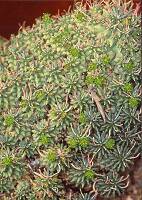
Euphorbia multiceps Hermann Wilhelm Rudolf Marloth discovered this very distinctive "manyheaded" Euphorbia in 1904 in the Laingsburg district. Not easily confused with any other species of Euphorbia, E. multiceps has a tall, conical main stem up to 600 mm high and 250 mm diam. at the base. The stem is covered with numerous horizontally spreading branches up to 75 mm long, decreasing upwards. Sharp-pointed, thick spines or modified peduncles arise from the stem and branches. Inflorescences are solitary at the tip of branches; glands light green.

Euphorbia eustachei
Discovered in 1910 near Matjesfontein by Charles Eustace Pillans, then Director in the Cape Government service and keen collector of Cape succulents. A unisexual, spiny, dwarf shrub, built up consisting of many short, crowded branches, forms a neat pincushion, 150 mm high and 300 mm or more in diam. Spines or modified peduncles are solitary, up to 50 mm long, ascending and rigid. Leaves are deciduous, up to 40 mm long and minutely hairy. The cyathium is solitary and produced near the apex. The involucre is larger in the male plants, glabrous or minutely hairy, with 5 pale-yellowish glands.
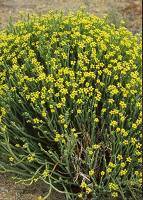
Euphorbia mauritanica
Euphorbia mauritanica was introduced into cultivation in Europe at or before the beginning of the 18th century and was believed to have originated in 'Mauritanica' in northwest Africa. A rounded shrub, densely branched, usually 1 m high, sometimes up to 2 m in height and usually wider in diam. Branches are cylindrical, fleshy, marked with alternate leaf scars. Leaves are deciduous, crowded on the youngest branches. Inflorescences consist of a male cyathium surrounded by 5 to 7 bisexual cyathia on a short terminal branch. Glands 5-8, bright yellow. Pistillate flower exserted from the involucre on a curved pedicel. One of the most widespread species but especially dominant in the Northern Cape.
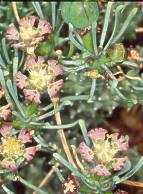
Euphorbia pentops
This species was described by White, Dyer & Sloane in 1941 from plants collected in 1930 by Hans Herre. The name translates as 'Euphorbia with five eyes' referring to the distinctive appearance of the involucral gland. Main stem stout, partly below ground. Branches numerous, short, with persistent peduncles. Cyathia solitary, arising from the axils of tubercles. Involucre cup-shaped, green with 5 glands and deeply laciniate lobes. The margins of the gland are divided into processes with the upper surface grayish or pinkish pubescent, except for the glossy green spot at the base of the gland.
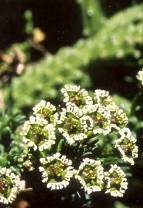
Euphorbia caput-medusae
'Medusa's head from the Cape ' aptly describes this species with multiple serpent-like stems arising from a short caudex (thick, woody stem). It was introduced into the Botanic Garden in Amsterdam in about 1700. Still plentiful near Cape Town where it occurs in deep sand or rocky outcrops on the coast. Plant often exceeding 1 m in diam., partly buried in the ground, covered with numerous crowded branches, spineless but with persistent remains of the peduncles. Cyathia solitary, produced in clusters at the apex of branches, peduncles up to 10 mm long; involucre broadly cup-shaped, 12 mm or more in diam., with 5 glands and 5 lobes; glands palmately divided into 3 to 6 linear processes, the undivided portion green and pitted and processes white. Pistillate flower slightly exserted beyond the lobes of the involucre.
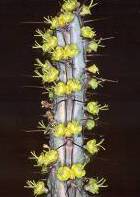
Euphorbia louwii
Named in 1980 by Larry Leach after Dr W.J. Louw who found it near Marken in Limpopo. Province. The 5-7-angular stem and the additional spine (nearly always present) distinguish this species from other similar species.
Euphorbia louwii is a spiny, shrubby species up to 1 m high, branching freely from the base, secondary branches sparse above. Branches greenish blue, 5-7-angled to subcylindric. Spine shields discontinuous and up to 10 mm long, bearing 5 slender spines, paired and the basal one is solitary and minute. Inflorescence with a horizontally arranged cyme (each flower is formed at the tip of a growing axis) of three cyathia, often additional ones arise in axils of bracts supporting lateral cyathia; peduncle short. Involucre funnel-shaped; glands 5, yellowish green.

Euphorbia waterbergensis
This species was first discovered by Mr Allan Lever in 1940 but Dyer described it only in 1951 when Dr L.E. Codd and Mr J. Ehrens made comprehensive collections. A spiny, succulent shrub, up to 1.5 m or occasionally more. Main stem suppressed, branching near ground level. Branches dark green or glaucous green, more or less erect, about 25 mm in diam., segmented into 20 to 200 mm long segments; 4-6-angled; angles furnished with paired spines on a continuous, horny gray margin, 1.5-2.0 mm broad. Spines in pairs, 5 mm long; prickles above spines rudimentary or absent. Cymes of 3-5 cyathia developed from the flowering eye just above the pair of spines; central cyathium male and developing first, with 2, 3 or 4 bisexual cyathia at right angles to the main axis. Cyathia glabrous with glands 5, contiguous, yellow, or light green. Capsules subglobose, reddish brown.E. waterbergensis is restricted to the northwestern foothills of the Waterberg Mountain Range. Conservation status: Vulnerable. Legally protected in Limpopo.
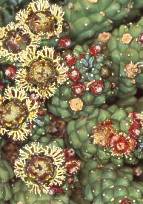
Euphorbia ramiglans
Discovered by Harry Bolus in 1883 but was only relatively recently rediscovered around Port Nolloth and Alexander Bay. Main stem stout, partly below ground, up to 200 mm high and 500 mm in diam. Branches numerous, up to 200 mm long, with peduncles rarely persistent. Cyathia solitary, arising from the axils of tubercles. Involucre cup-shaped; glands 5, green with 4-6, whitish, finely branching processes.
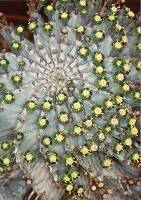
Euphorbia horrida
This attractive but rare form of Euphorbia horrida is one of several forms known from Jansenville in the Eastern Cape to Oudtshoorn in the Western Cape. This form is often seen in nurseries. The specific epithet means bristling, referring to the formidable rows of spines up to 40 mm long. Spiny succulent shrub, forming irregular clumps up to 1.5 m high. Branches erect, cylindrical, 100 to 150 mm thick, angles 10 to 20, wing-like, prominent. Spines or modified peduncles up to 40 mm long, very rigid. Cyathia solitary, pedunculate. Involucre finely hairy with 5 glands and 5 large lobes. Glands green or purple.
References
- Carter, S. & Eggli, U. 1997. The Cites checklist of succulent Euphorbia taxa (Euphorbiaceae). German Federal Agency for Nature Conservation.
- Eggli, U. (ed.). 2001. Illustrated handbook of succulent plants: Dicotyledons. Springer-Verlag, Berlin.
- Swartz, H. (ed.). 1983-1996. The Euphorbia Journal 1-10. Strawberry Press, Mill Valley.
- Turner, R. 1995. Euphorbias, a gardeners' guide. Batsford, London.
- White, A. Dyer, R.A. & Sloane, B.L. 1941. The succulent Euphorbieae (southern Africa), vols. 1 & 2. Abbey Garden Press, Pasadena.
Credits
Robert H. Archer
National Herbarium Pretoria
April 2005
Plant Attributes:
Plant Type: Perennial, Shrub, Succulent, Tree
SA Distribution:
Soil type:
Flowering season:
PH:
Flower colour:
Aspect:
Gardening skill:
Special Features:
Horticultural zones






Rate this article
Article well written and informative
Rate this plant
Is this an interesting plant?
Login to add your Comment
Back to topNot registered yet? Click here to register.